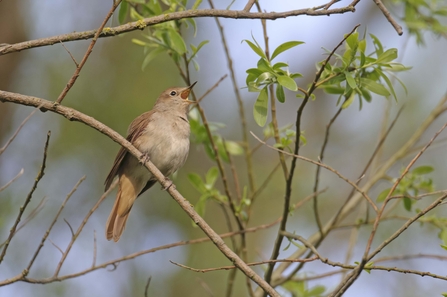
©Chris Gomersall/2020VISION

©Chris Gomersall/2020VISION
• New plans have been unveiled by Medway Council that could lead to thousands of new houses being built on a Site of Special Scientific Interest, which could also threaten the legal protection of thousands of wildlife habitats and natural beauty spots across the UK
• National conservation groups are joining forces with Kent-based organisations to campaign to protect Lodge Hill, the best place for nightingales in the UK, from being lost to new housing
• The much-loved nightingale, famed for its rich song, has seen its decline in England by 90% in the last 50 years placing it on the UK Red List for threatened species, and Lodge Hill is one of the last strongholds for the bird in the UK
The decline of the species is so alarming that nightingales are listed among our most threatened birds and included on UK Red List for birds. However, the land is being targeted by Medway Council as a prime location to build thousands of houses
New documents released by Medway Council in Kent are set to test the Government’s safeguards that prevent many of our best wildlife havens, natural habitats and beauty spots from being lost to new housing developments.
If approved, the authority’s Local Plan could pave the way for thousands of new houses to be built on Lodge Hill, land that should be protected for nature.
Lodge Hill in Kent is recognised as one of the last strongholds for nightingales in the UK, an enigmatic bird that has seen its population in England drop to less than 6,000 singing males from over 60,000 a few decades ago. The decline of the species is so alarming that nightingales are listed among our most threatened birds and included on UK Red List for birds. However, the land is being targeted by Medway Council as a prime location to build thousands of houses.
The area includes ancient woodland with rare grasslands which are home to mammals, reptiles, amphibians, rare insects and flowers as well as nightingales. The importance of Lodge Hill is so great that in 2013 the Government declared it a Site of Special Scientific Interest (SSSI) for nightingales and the habitat.
In addition to being recognised as a nationally important site for nature, local people have also demonstrated that they value Lodge Hill. Echoing the concerns of conservationists, local communities spoke out when the local authority approved a developer’s planning application to build 5,000 houses on the area back in 2014. The strength of opposition from local groups could not be ignored and the decision will go to a Public Inquiry in 2018.
Stephen Trotter, Director, The Wildlife Trusts England, says: “Lodge Hill is an important test of whether the Government is committed to its stated aim of leaving the natural environment in a better state than this generation inherited it. We should be celebrating and protecting sites of international wildlife importance like Lodge Hill - not building on them.”
Alan Johnson, south east conservation manager for the RSPB said: “Flying thousands of miles from Africa, nightingales arrive at Lodge Hill every year to spend the summer in Medway where they nest and raise young. As they arrive they blend perfectly into their environment as they serenade the Kent countryside with their distinctive song. So it is deeply concerning that one of the few areas where they are thriving could be lost under bricks and concrete, threatening the UK’s nightingale population as well as the strength of protection Sites of Special Scientific Interest should receive.”
Home to thousands of species, SSSIs are officially recognised as among the best places for wildlife in the UK, and are legally protected to safeguard us from losing these invaluable natural places. This level of protection should ensure the area is preserved as a home for wildlife today and for future generations.
There are just 4,000 SSSIs in England, and only Lodge Hill has been designated specifically for its nightingale population. The Government’s National Planning Policy sets out that land that has been designated a SSSI can only be developed if all other options for potential developments have been exhausted. It is not clear that Medway Council has fully explored every alternative or option to allocating Lodge Hill for development, and the fact that Lodge Hill is a SSSI is not obvious in the Council’s consultation document.
Greg Hitchcock, Conservation Officer for Kent Wildlife Trust added: “Despite stating in the consultation document that such sites will be given a high level of protection from development, none of the four options presented to the people of Medway exclude a new town on Lodge Hill. Medway Council should be standing alongside the many conservation organisations to protect Medway's environment, not help destroy it.”
The potential loss of Lodge Hill and what this may mean for other SSSIs has brought together conservation groups from across Kent and the UK. Alongside Kent Wildlife Trust campaigning to protect Lodge Hill are RSPB, Buglife, Friends of the North Kent Marshes, Medway Countryside Forum, Butterfly Conservation and Woodland Trust.
Medway Council's public consultation runs from 16 January to 6 March 2017. To find out more about the concerns being raised by conservation groups, and get involved in saving Lodge Hill from development visit: www.kentwildlifetrust.org.uk/lodge-hill
fill in the RSPB's e-action here